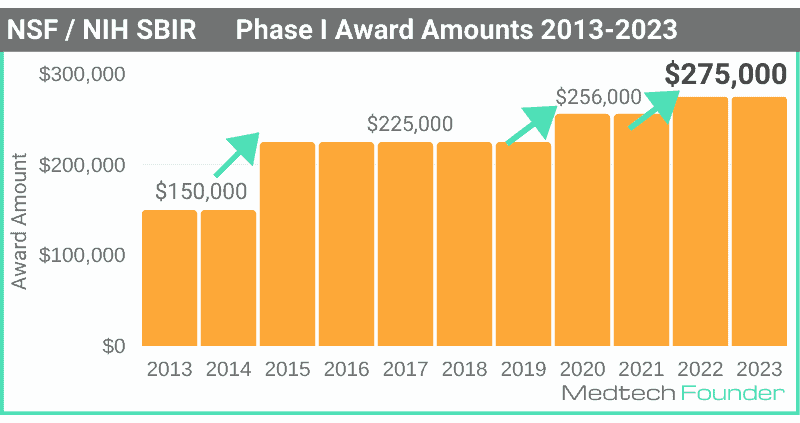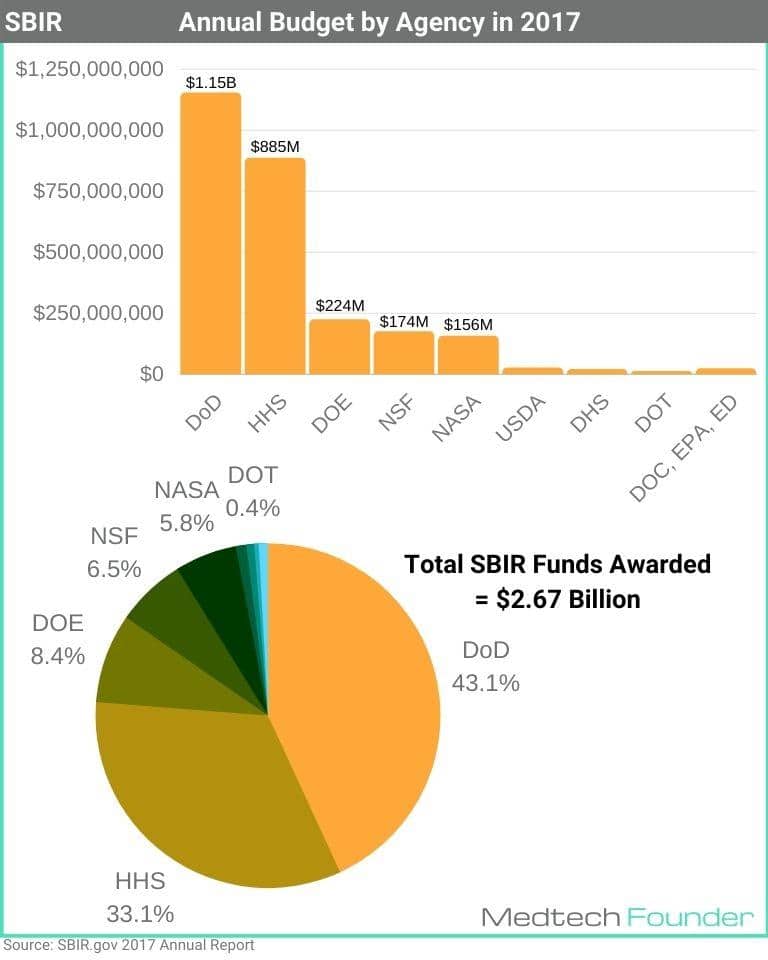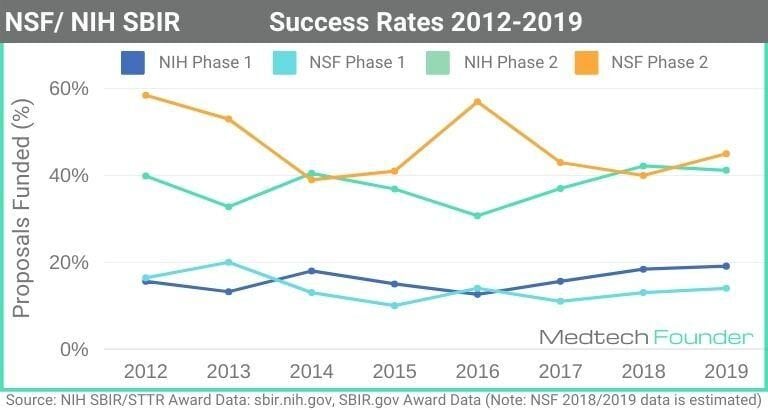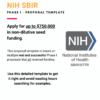One of the best-kept secrets in the world of startup capital is the SBIR Grant. The federal government has billions of dollars it’s congressionally mandated to give away every year to early-stage founders and inventors like you— and all you have to do is ask (in the right way).
Best of all, these dollars come with very few strings attached. In fact, it’s about the closest thing to free money that you can get.
With awards starting at $275,000 for a Phase I National Science Foundation (NSF) SBIR grant, it’s quite possibly the best deal around for starting your medtech business.7
So, how do you get in the door of the massive Small Business Innovation Research program?
To win NSF SBIR grant money in 2024 you need to understand what makes a proposal stand out and what the government agencies are looking for.
The top three things that get winning SBIR grant proposals funded are:
- Establishing a relationship with the Program Director
- Nailing the fundable sweet spot
- Demonstrating traction
Once you understand how the SBIR grant proposal review process actually works, following this strategy is what will sway the review panels and the all-important program director (the key person that makes a funding decision).
In this article, I’ve pulled together the strategies I wish I knew before I wrote my first SBIR grant proposal.
I know how hard it can be to find real SBIR proposal examples. And not just examples, but successful strategies to navigate the process.
These hard-won insights could have easily saved me three years of falling short before successfully winning the first SBIR grant for my business.
The insights I’m sharing with you are 100% based on my own experience in successfully winning nearly $3M in SBIR grant funding since then.
Table of Contents
How to Win NSF SBIR Grants in 2024?
The first tip is to spend less time actually writing the proposal and more time building a fundable business focused on these three factors.
The key is to position your project so that it fits into NSF’s fundable sweet spot. Using the tactics I outline below will align your project perfectly within the agency’s sweet spot.
The first thing to realize is that the agency is not seeking a financial return.
Wait, so they will give me money and not want a return at some point? That’s right.
What NSF wants is very different from any investor. The decision-makers are civil servants that are motivated and congressionally mandated to support businesses and thereby benefit society.
They are motivated by access to technology, the advancement of science, educational opportunities, support for under-represented groups, and societal impact.
Just to be clear, there’s absolutely nothing wrong with civil servants. We need them and the folks at these agencies are some of the best and smartest around.
They just have a different set of motivations in that role and that’s crucial to understand.
The best way for them to demonstrate success and justify their budgets to congress is to point to specific examples of how they have achieved those goals through the businesses they choose to support.
If you want to increase your chances of getting funded you want to make it super easy for the program directors to point to your business as a poster child for these non-financial success metrics.
We’ll break that down more later.
But first, let’s take a step back and start at the top. What exactly is the SBIR Program?
What is the SBIR Grant Program?
The Small Business Innovation Research (SBIR) program, is a network of programs, spread across a dozen federal agencies.
Established in 1982, through the Small Business Innovation Development Act, the SBIR grant program was created across multiple agencies (along with its cousin the Small Business Technology Transfer program (STTR))
The main purpose of the legislation is to stimulate technological innovation and increase private-sector commercialization.
It was framed as a way to help out any American with a great idea but little access to capital.
SBIR/STTR awards are not traditional government contracts. They are not awarded to procure services or goods for the government. In fact, no tangible benefit is received by the government.
That said, it’s not as if you just reach into the SBIR cookie jar and pull out a million bucks. As with anything involving the federal government, there’s a process.
It should be noted that this is not the only tech-related government grant program.
But it is the largest, broadest, and arguably the most accessible to small business entrepreneurs and inventors like you.
There are three award phases with increasing award amounts that can exceed $1.25M starting in Phase II.
- Phase I is focused on demonstrating proof of concept – anywhere from whiteboard to prototype. Awards range from tens of thousands to $275,000, over a period of 6 to 12 months.
- Phase II is for those doing deeper R&D on a proven concept and may be more than $1,000,000 over a two-year period.
- Phase III is where a project may transition to actual paid contracts and purchases.
In this article, I’ll focus on strategies to get that first Phase I award. This is the entry point to unlock millions of additional dollars in Phases II and III.
SBIR grants fund startups and small businesses with innovative products and services
The NSF SBIR/STTR programs provide startups and small businesses with non-dilutive funding to conduct research and development work.
The funding is intended to spur the creation of innovative new products and services and to drive the commercial success of the small business.
Generally, the topics included are broad to allow as many eligible science- and technology-based small businesses as possible to compete for funding.
By doing so, NSF’s programs meet the purpose of the legislation by transforming scientific discovery and innovation into both social and economic benefit, and by emphasizing private sector commercialization.
Interestingly, agencies like the NSF and NIH do not test, verify, or otherwise use the technology developed under their SBIR/STTR grant awards.
The Department of Defense (DoD) on the other hand, is much more targeted in its approach and may have more specific interests compared to the “civilian” agencies.
Here’s what they look for when determining which companies to fund:
- Transformative: Your innovation could make a difference to people worldwide or revolutionize an industry.
- High-risk: Your product is based on unproven technology that needs further testing (and funding for that testing).
- Market pull: You have evidence that your product or service could meet an important, unmet need for your customers.
- Scale: If you successfully bring your product or service to the market, it could form the foundation for a scalable business and make a large impact on your target market.
The great news is that the healthcare field is filled with these kinds of problems.
So it’s no wonder a full 40% of SBIR phase I awards are medical, biomedical, or digital Health-based.
That’s why healthcare and medtech innovations are such a great fit for these programs and why I’m so invested in helping anyone with great healthcare solutions get access to these funds.
How much grant money is awarded?
In 2022 funding amounts for a Phase I SBIR grant were raised to $275,000 and are staying at this level for 2024.

First, the SBIR program is constantly being updated so keep an eye on the most recent published guidelines (NSF SBIR Phase I Solicitation 2024).
The most recent and important changes to be aware of are:
- A required Project Pitch as the first step for Phase I and,
- In 2022 funding amounts for a Phase I SBIR grant were raised to $275,000 and are staying at this level for 2024.
The Project Pitch
The three-page NSF Project Pitch allows startups and small businesses to get quick feedback (within three weeks) at the start of their application for Phase I funding.
If your Project Pitch is a good fit for the program, you will receive an official invitation from NSF to submit a full proposal. If you’re not invited to submit, you’ll be told why your project is not appropriate for the program.
This is the first opportunity to connect the three winning ingredients of a successful proposal – establishing a relationship with the Program Director, nailing the fundable sweet spot, and demonstrating traction
Funding Levels
NSF has heard feedback from entrepreneurs that the previous funding levels were just a bit too tight.
There’s also something about the quarter-million-dollar threshold that gets the attention of outside investors, something that the NSF is keen to help companies attract as soon as possible.
Both of these recent changes mean that SBIR grants are an even sweeter deal in 2024.

What are the typical SBIR grant success rates?
The SBIR/STTR programs are highly competitive. While success rates vary year-to-year, only a fraction of proposals submitted are selected for an award.
The big secret here is that many awards (upwards of 20%) are not even reviewed due to simple errors like missing documents, wrong formatting, or lack of eligibility.

Counting these throw-away proposals and including ones that don’t have the benefit of high-impact tactics, the funding rates are:
- As of 2019 the Phase I funding rate was between 15% and 20%.
- The Phase II funding rates typically vary between 30% and 55%.
Being armed with just a few insights, like the ones I’m sharing here, can easily increase these percentages by 2-3X.
In fact, once I figured out how to properly position my proposals, my success rate increased from <10% to over 80%.
If you told me that I had a 70% chance of bringing in $275,000 in 6 months by doing just a bit of leg work I would take that deal all day long.
Economically speaking, the expected value of this effort on a monthly basis is over $32,083 per month!
This number wasn’t quite so high just a few years ago, which is why right now is the perfect time to take full advantage of the SBIR grant program.
This is especially true if you’re a medtech or healthcare innovator. Luckily since you’re here, you’re already one step ahead.
Why this SBIR grant funding is so attractive
Now, besides the fact that you could secure upwards of a quarter-million dollars for your business, there are few other pluses to be aware of.
1. Non-dilutive funding
I mentioned this before, but it bears repeating.
You will not find any other funding sources out there (short of actual revenues) that won’t ask to be paid back (with interest) or ask for an ownership stake in your business in exchange for $275,000.
It just doesn’t happen.
Believe me, if more people just knew that they could raise money this way, the government would have a stampede on their hands.
2. It makes investors happy
Now, maybe you don’t have any investors yet. That’s fine.
Once you’re able to raise this kind of SBIR money, investors tend to take notice. You are no longer a fledgling business that nobody will invest in.
Despite what many say, investors love company. They are looking for any kind of signal that a business is worth investing in.
Securing SBIR money lets them know that you were able to convince a federal agency to invest in your idea and put some serious money behind it. It’s a leverage point that you are free to use to your advantage.
If you already have investors, well, they love nothing more than increasing the value of your business without being diluted themselves.
If you are looking to go straight to venture capital, check out my post on the Best Digital Health Investors. I give you my top 3 recommendations along with typical round sizes, what’s important to each investor and even a first point of contact.
3. It’s risk-free
The only real risk here is opportunity cost.
4. You’ll be eligible for free and supplemental resources
Being an awardee makes you eligible for additional programs.
Some of these programs like LARTA include some free business consulting hours (NSF and NIH).
You’ll be able to network with other awardees and leverage their investor, customer, and partner networks.
For SBIR Phase II awards there are even more options for funds matching and higher dollar amount budget requests for diversity and inclusion initiatives for veterans, teachers, post-doc, and more.
You’ll be eligible for additional funding sources like some of the following
- Phase IIB Supplemental funding (NSF) – Will match 50% of any outside funds up to $500k ($1 million from third parties)
- TECP – Funding for additional research that goes beyond the Phase II project’s objectives. Additional research is anticipated to enhance the commercial potential and lead to partnerships with industrial partners and venture and angel investors – 20% of Phase II award amount (ie $200k)
- REU (Research experience for undergraduates NSF) – Basically expenses covered undergraduate intern, but great for some low-cost high-skill labor.
- Technical and Business Assistance (TABA)(NIH/NSF) – Free quantitative market research from Foresight
You can find a summary of these supplemental funding sources offered by the NSF here
STTR vs SBIR Which is Best?
This is a question that many people ask.
While most strategies outlined here apply to both SBIR and STTR, they’ll be most effective for SBIR applicants.
Here’s why.
SBIR grants are intended for existing small businesses where a majority of the work and business execution occurs.
STTR grants on the other hand are intended for more of a collaboration between a small business and a non-profit organization (eg. a university).
While this might sound attractive at first, it’s actually more of a hindrance in my opinion.
Let me explain.
Principal Investigator’s Primary Employment
The STTR program is the typical starting point for professors and researchers that are primarily employed by a university or non-profit research institute.
This is because the STTR grant provides flexibility for the Principal Investigator (PI) to be primarily employed by the university or by the business.
An SBIR grant on the other hand has a strict requirement that the PI is primarily employed (>50%) by the small business.
This of course weeds out many of the technical innovators that wish to be PI but are currently employed at universities. Hence the attractiveness of the STTR.
The challenge here is that the STTR links your business too closely to the non-profit institution.
You will need shared intellectual property agreements in place and you will also be funneling your hard-earned grant money straight to the university’s overhead costs.
Working with a University
Overhead costs at universities can be as high as 60% of the direct costs. Many also have additional fringe benefit costs that can be as high as 35% of labor costs.
Indirect costs are the related costs of using the University’s facilities and administrative support that cannot be claimed as direct costs. Indirect costs are not profit; instead, they are part of the real costs of conducting the outside funded R&D.
So let’s say you were just awarded a $200,000 Phase I STTR. grant And you wanted to spend 60% of the funds with the university for use on specialized lab equipment or lab capabilities that are vital to your project.
That’s $120,000 you’ll be allocating for university-supported work. Great! But not so fast.
The hidden costs
If you take into account typical university direct costs of let’s say 50%, that means you’ll only actually have $80,000 applied to the actual work, the other $40,000 is what the university charges as overhead costs.
Now you probably need someone to help with the work. Let’s say it’s a post-doc that will help on this project with 50% of their time. Now you’ll need to pay for their fringe benefits at a 25-30% level of their salary.
Let’s say a typical post-doc makes $50,000 a year. That’s $12,500 that you’ll need to pay for their salary plus $3,750 in fringe benefits. That’s $16,250.
So now you’re down to $63,750 of funds applied for actual lab work. But wait.
Most universities will also then charge lab access fees which could be on a per equipment or per hour basis. Let’s say that will run you $6000 for basic run-of-the-mill lab capabilities for the 6-month duration of our grant.
You are now down to $57, 750 (48% of your original budget) that you can spend on materials, supplies, prototyping, equipment, and generally moving your program forward with one part-time post-doc.
When you take an honest assessment, you will likely find that there are way more productive and efficient ways to spend that $120,000 to advance your business.
Efficiently spending your cash
I’ve made this exact trade-off before in projects that required fairly specialized tools and resources (microfluidics, semiconductor cleanroom process, microfabrication, etc).
In each of those cases, access to these resources alone did not justify the STTR funding strategy.
In early-stage business, your cash is your lifeblood.
By leaning too heavily on universities through an STTR a majority of your cash (in this example 52%) will be lost to university overhead and expenditures that don’t actually move your business forward.
Throw in some of the other constraints around intellectual property, speed of execution with academic institutions, and anchoring to academic collaborators, and the STTR pathway will begin to sap away whatever entrepreneurial momentum your project had.
Clearly, I’m a proponent of the SBIR route. I just think it aligns much better with the goals of a real business.
The STTR is kind of this half in, half out program that doesn’t really make sense unless your goal isn’t to actually launch a real healthcare or medtech business.
Having shared these thoughts, I’ll be more objective and review the more generic reasons to pursue either an SBIR or STTR.
Here are the reasons to go after SBIRs:
Flexibility to subcontract with consultants.
First, when you submit an SBIR proposal you can include another company – large or small, as a subcontractor to enhance the capability of your team.
You can also include a university or another type of research institution as a subcontractor.
However, if you don’t plan to include a non-profit research entity in your project as a subcontractor, then STTR is not a consideration.
Another situation when the SBIR gran is best – If you decide to subcontract to a Research Institution – but don’t need to subcontract more than 33% of a Phase I research effort to the RI, then an SBIR grant is the most appropriate choice.
SBIRs are Investor-Friendly
Intellectual property is free and clear.
Sometimes potential investors do not like the idea of involving a non-profit in a project, whether it be because of perceptions about the “culture” of such participants or concerns about the non-profit’s claim to intellectual property rights on the project.
In this case, an SBIR grant would be the most appropriate choice.
Note that the reason for this concern is that if a small business participates in an STTR it is required that the small business and the not for profit entity establish an agreement that details the allocation of intellectual property.
No requirement to work with a non-profit
A final reason to consider SBIR grants is if the personnel at the research institution would prefer to participate in the project as an independent consultant rather than as representatives of the university or Federal Laboratory.
A small firm hiring consultants does not qualify for STTR grants because no nonprofit RI is acting as a subcontractor.
Here are the Reasons to go after STTR grants:
You plan to subcontract more than 33% of the work
To have the best team, you need to subcontract a large portion of the award.
SBIR Phase I projects constrain the use of subcontractors because no more than 33% of the research can be subcontracted; STTR is much more generous, allowing for up to 60% of the R&D to go to the nonprofit RI.
The guidelines for STTR specifically state that the small business must perform 40% of the work on the project and the research institution must perform at least 30% of the R&D.
This leaves an additional 30% that can be outsourced to either the research institution or another subcontractor.
You must have a strong tie to a particular university
Here, the small business and the research institution view themselves as equal partners on the project.
Again, STTR is described as a “collaboration” between the two, suggesting the players are equals even though the award always goes to the small business and the firm must maintain overall control and has responsibility for the project.
Sometimes the applicant may conclude that there is a greater probability of winning an award when teamed with a Research Institution.
How SBIR Grant Proposals are Evaluated (behind the scenes)
Let’s start with a quick review of the typical timeline
Month -2 -> 0: Preparation phase. 3-page pitch, Commercial feasibility, Letter of Support, Team building, Program Director outreach.
Month 0: Finalize and prepare a full proposal submission
Month 2 -> 4 after full submission: Proposers, especially those in consideration for funding, may be contacted by the Program Director any time after the panel if the panel or Program Director have questions that must be answered for the proposal to be fairly and completely evaluated. This process of interaction with the Program Director is called “due diligence” and is generally a good sign.
Month 4 -> 6 after full submission: All proposals which undergo the full merit review process receive official notification of the decision (with anonymous written reviews).
Month 6 > 7 after full submission: Phase I awards begin. Awards made based on proposals submitted in a given submission window will have a start date (first funds disbursed) no later than seven months after the closing of the window, and usually sooner.
There are extensive official tutorials for later, but this article (informed by my first-hand experience) should help get you up and running
Start Relationships with the Program Directors Early
I can’t stress this enough.
Here are the current NSF SBIR Program Directors for Digital Health, Medical Devices, Biomedical Technologies, and Biological Technologies.
It is the Program Directors’ job to fund you. It is also their job to field questions and find the best opportunities to fund young hungry companies.
But, you must reach out to them early and get on their radar.
Here’s how you do that:
- Look up the Program Directors’ contact information.
- Identify 1-3 Directors that seem to fit the kind of innovation and business you have in mind
- You can use my email template for a first cold connection.
***************
Subject line [NSF SBIR Phase 1 – Proposal Suitability Inquiry]
Dear [Program Directors Name],
I am [Name] the [title/position] of [Company name (link your website!)].
Our company is developing … for which we’d like to submit an SBIR Phase I proposal.
This will be the first proposal for our team and as such we would like to get early feedback on the suitability of our proposal for the current solicitation under your technological area.
Specifically, we would like to confirm the following:
- Project pitch process (timing, emphasis, recommendations)
- Our standing as Woman-owned, Disadvantaged, or HubZone business concern
- I-Corps and/or adjacent funding mechanisms (REU and Phase IB matching) that we may be eligible to pursue as well.
I am available for a call at [telephone number].
Thank you
***********
I recommend linking your website directly in this email. Without a website or at least a landing page, you’ll miss a key opportunity to convey legitimacy and gain the program director’s trust.
Getting a landing page up and running from scratch can be done cheaply in just a few hours. You can get started for just $2.65/month with Bluehost. It’s the fastest way to get your project an online presence for this outreach phase.
Understand What Program Directors Value Most
As a Program Director, you’re on the hunt for great companies to support.
You’re also looking for ways to demonstrate the impact you’re having in that role.
There are two main ways this happens in practice:
1. The Sexy Story
Here the PD is looking for a great story to tell, one that makes a big splash through an early acquisition, venture capital investment, or partnership with well-known and established companies.
This gives the PD bragging rights for his/her ability to spot talent and elevate the agency’s impact in the eyes of the administration and the public.
2. Broader Societal Impact
There are many companies with potentially impactful innovations but there are far fewer that advance NSF’s other goals; namely, broader societal impact through supporting historically disadvantaged groups.
Congress directs the SBIR Program to foster and encourage participation in innovation and entrepreneurship by women and socially and economically disadvantaged persons.
There are three categories defined very specifically as:
- Woman-owned small business
- Small Disadvantaged Business (SDB)
- A small business that is at least 51 percent owned by one or more individuals who are both socially and economically disadvantaged.
- HUB-Zone Small Business:
- Have its principal office located in a HUBZone
- Have at least 35 percent of its employees live in a HUBZone
Agencies specifically report funding numbers for these categories every year.
In 2017 (combined Phase I and II):
- 12% of awards went to Women-owned Small Businesses.
- 5% of awards went to Socially and Economically Disadvantaged Small Businesses
- 3% of awards went to HUBZone-Certified Small Businesses
Given that these numbers are combined Phase I and II, it’s pretty clear that these categories aren’t keeping up with the average success rates.
Program directors would love nothing more than to show that they’ve made an impact by funding excellent proposals in these categories.
By qualifying for one of these categories (and following the strategies outlined here), you’ll quickly check off the high-value boxes in the eyes of any PD.
In either of these scenarios, whether it’s the sexy story or the societal impact angle, the PD will be inclined to find a way to fund you.
Of course, if you can check both of these boxes you can really supercharge your chances of getting funded.
How to target your pitch right in the SBIR Sweet Spot
Now that you’re aware of the key areas that get a PD’s attention, let’s touch on how to sweeten the deal further.
The first thing to know is that the SBIR grant program sees itself as “America’s Seed Fund”. It’s literally their motto.
They’re not venture capital, they’re not angel investors nor are they government contracts.
They are motivated by planting a seed so that others can take it forward and nurture it.
They don’t have the ability to put in $10-100M investments. That’s not their focus.
They want to give just enough money to make a meaningful impact so that you can go from zero to a business that can attract next level investment opportunities or generate self-sustaining revenues.
So in practice what this means is that they need to have a pretty clear idea of how, if successful, your proposed goals take your business from seedling to an investable enterprise.
It must be tangentially clear that the SBIR grant money will enable your business to be successful.
Basically, you need to fill in this statement:
If we can demonstrate/complete/prove X then customer/investor/partner has committed to buy/invest in/launch our product or service.
Presenting your proposal in the form of an if/then statement makes it crystal clear to the PD what impact they can expect to have by funding your proposal.
In practice, it’s easy to state something like this, but hard to know if it’s actually true.
This is where having traction and customer or market validation is key. This is what generates the data to support your if/then funding statement.
More on that a little later
How to position your project as an innovation
SBIR grant proposals are reviewed by a so-called Peer Review Panel. The function of this panel is to provide an outside unbiased perspective of the merits of your proposal.
The Peer Review Panel
For Small Business Innovation Research/Small Business Technology Transfer (SBIR/STTR) proposals, reviewers often have one or more of the following characteristics:
- Advanced degree(s) in science or engineering
- Industrial or entrepreneurial expertise in one or more of the market or technology areas that’s part of the SBIR/STTR portfolio
- Experience founding, leading or investing in small businesses or startups
- Other experience in new technologies.
I’ve been part of these review panels (5-7 peers review ~20 proposals) so I know first-hand how these panels contribute to the selection process.
The recommendations provided by the panel are only advisory. The final decision still lies with the PD.
However, the panel response is an important factor in establishing the innovativeness of your proposal.
Essentially the panel members are asked to read your proposal in full, provide commentary in 3 specific areas:
- Intellectual Merit
- Broader Society Impact
- Commercial Impact
Here’s a summary of the specific questions panelists are asked to keep in mind when providing commentary.
Criterion 1: Intellectual Merit.
The Intellectual Merit criterion encompasses the potential to advance knowledge. The following elements should be considered in the review of Intellectual Merit:
- What is the potential for the proposed activity to advance knowledge and understanding within its own field or across different fields (Intellectual Merit)?
- To what extent do the proposed activities suggest and explore creative, original, or potentially transformative concepts?
- Is the plan for carrying out the proposed activities well-reasoned, well-organized, and based on a sound rationale? Does the plan incorporate a mechanism to assess success?
- How well qualified is the individual, team, or organization to conduct the proposed activities?
- Are there adequate resources available to the Principal Investigator (PI) either at the home organization or through collaborations to carry out the proposed activities?
Criterion 2: Broader Impacts.
The Broader Impacts criterion encompasses the potential to benefit society and contribute to the achievement of specific, desired societal outcomes.
The following elements should be considered in the review of Broader Impacts:
- What is the potential for the proposed activity to benefit society or advance desired societal outcomes (Broader Impacts)?
- To what extent do the proposed activities suggest and explore creative, original, or potentially transformative concepts?
- Is the plan for carrying out the proposed activities well-reasoned, well-organized, and based on a sound rationale? Does the plan incorporate a mechanism to assess success?
- How well qualified is the individual, team, or organization to conduct the proposed activities?
- Are there adequate resources available to the PI either at the home organization or through collaborations to carry out the proposed activities?
Criterion 3: Commercial Impact.
The Commercial Impact criterion focuses on the potential of the activity to lead to significant outcomes in the commercial market.
The following criteria should be applied in the review of the Commercial Impact criterion:
- Is there a significant market opportunity that could be addressed by the proposed product, process, or service?
- Does the company possess a significant and durable competitive advantage, based on scientific or technical innovation, that would be difficult for competitors to neutralize or replicate?
- Is there a compelling potential business model?
- Does the proposing company/team have the essential elements, including expertise, structure, and experience, that would suggest the potential for strong commercial outcomes?
- Will NSF support serve as a catalyst to improve substantially the technical and commercial impact of the underlying commercial endeavor?
- For Phase II proposals only: As a result of Phase I, did the firm succeed in providing a solid foundation for the proposed Phase II activity.
The Rating Scale
At the end of the day, each panelist is asked to provide a final rating for the proposal. Usually using a scale the looks something like this:
- Excellent: Outstanding proposal in all respects; deserves the highest priority for support.
- Very Good: High-quality proposal in nearly all respects; should be supported if at all possible.
- Good: A quality proposal worthy of support.
- Fair: Proposal lacking in one or more critical aspects; key issues need to be addressed.
- Poor: The proposal has serious deficiencies.
Much of this comes from the proposal body itself, which as I mentioned earlier, should be the last thing you focus on.
Keep in mind that the panelists are just asked to provide their opinion on the proposal for the PD consideration.
If you’ve already established a strong connection with the PD through active and thoughtful outreach, they will be primed to view panel commentary in a way that ultimately favors you.
Panelists will not be privy to the existing communication channels between you and the PD.
Focus on Commercial Feasibility, not Grant Writing
The proposal body is the least important factor. Instead, establishing a relationship with the PD, nailing the sweet spot, and demonstrating traction are what get proposals funded.
So how do we get traction with any funding? This is a common sticking point for many founders. Here’s how.
How to demonstrate traction for your project
Focus on a compelling business opportunity, not a research project. The key here is to generate credible outside data that shows a business opportunity exists for your solution.
Typically this requires extensive market research efforts that include primary interviews with key opinion leaders, potential customers, budget managers, investors, and potential business partners.
With a bit of leg work, this is definitely something that a motivated team can make progress in. But it takes time.
The typical problem here is that you don’t have the right connections in place and don’t even really have anything to show them. It’s the chicken or the egg problem.
You need the funding to create the product or service that customers can evaluate. I get it, I’ve been there. But if you’re thinking like a business owner you need to switch your perspective.
So how do you get that primary feedback on a product/service that doesn’t exist? Well, that’s a bit of an art.
There aren’t really any shortcuts here. There are only efficient and inefficient ways to go about this.
The secret here is to find the lowest cost methods (preferably free) to validate that the market wants your solution.
You’ll need two things:
- A demo
- High-value and specific feedback
1. Create a demo
Producing a demo of your product or service before you have funding is not easy, but here a few ways I’ve been able to get around this problem.
You will typically have a physical product or a service. In either case, you can generate some sort of representation of your concept.
If you have a physical product, you need to generate some nice graphics, a video, animation, or even a physical mock-up.
These kinds of services are readily available at low cost from freelancing marketplaces.
A great place to find expertise with 3D printing, animation, and machining is Fiverr.
Keep in mind that your physical demo doesn’t have to actually work. It just has to physically represent how your product will look and feel.
Along with some nice graphics or a video, you will be able to have a meaningful high-value conversion with a customer or stakeholder to validate their willingness to use/pay for your product.
If you have a service, you will also need to generate a mockup of the user journey.
This can typically be done through video, animation, slides, or software.
Again, freelancing services will be able to get you something tangible for <$100.
Generating a skeleton app or demo software will run you $300-$500 for a developer to put together something fairly basic with no bells and whistles.
I recommend keeping your expenses for any of these mock-ups well below $1000.
You will be surprised how much value can be generated by finding the right freelancer for your project.
Even if you are technically inclined you should still consider using outside help for this.
Remember you’re on a mission to get traction and demonstrate market acceptance, not to spend hours developing a mock-up. You need to be efficient.
2. Solicit high-value feedback
It’s not enough to get feedback from family, friends, or colleagues. You need more.
I know it can feel uncomfortable, but you need to go out and find fresh unbiased opinions about your concept.
Sometimes you need to go straight to patients or consumers. Other times you need to get in front of doctors or hospital administrators. You might even need to get in front of insurance providers.
Unless you’re extremely well connected across all these are (which I wasn’t) you’ll need some help.
You can probe your network, ask for a warm introduction, or even cold call/email folks. This all takes time. You can and should do this, but let’s be efficient.
If you want to target the right folks and get your product or service in front of them you should leverage a user experience or market validation service.
These services have existing networks of doctors, patients, payors, key opinion leaders. Having efficient and reliable access to these networks is the most efficient way to get high-value primary feedback for your product or service.
Here’s how it works:
Services like Human Factors MD and KOL groups will be able to provide high quality and target market feedback for your project.
This might just be 10-15 key people in your key area, but that kind of feedback will be super valuable. Reserve this avenue for highly specialized folks that are difficult to find.
If you want to get lower fidelity feedback, say people with diabetes, or pediatricians. I suggest using a service like SurveyMonkey or InCrowd. You’ll be able to access hundreds of possible patients or customers.
A timeline of 3-4 weeks is reasonable to have a mock-up ready and have a set of concrete market data that will begin to demonstrate traction for your project.
3. Start your customer list
Take the high-value feedback and use it to tailor your product or service. Use the statistics from your feedback to support your proposed next steps.
For example, if you find that 20/30 respondents find your innovation would significantly save them time, money, or quality of life and that they would be willing to use it, you now have data to support your innovation.
Collect contact information for respondents that expressed interest. At least a first name and email address. Provide them a link to your website. Treat them as a potential customer.
Having a contact list of interested and potential customers is a huge asset to any digital business. You should take every opportunity to curate and build your customer list.
The benefit is two-fold:
1) You have a set of interested alpha-testers already familiar with your concept
2) You can build a following you can use to validate future iterations of your product or service.
4. Use tools to be efficient
As you build your email list with contacts from your direct feedback efforts, survey respondents, personal out-reach, and website, you’ll need a way to manage this efficiently.
Even for projects at this early stage, I recommend using an email marketing provider like ConvertKit.
This is what I use for my businesses. It is the best email marketing tool for small-to-medium audiences and is used extensively by bloggers.
It’s great for a few main reasons:
- You can get started for free for up to 1000 email subscribers
- You can create advanced email sequences based on different site actions. Note: 59% of customers say that personalization influences their purchasing decision
- Next, you can create drip campaigns and link sequences together based on actions inside of emails.
- Finally, it’s perfect for medtech businesses because their text emails look professional and don’t have annoying brandings like with MailChimp and other platforms.
At the very minimum, you will have concrete data to demonstrate that you have real and concrete contacts for potential future customers/users.
You’ll be ahead of most other SBIR applicants in testing and pathfinding your commercialization strategy.
Congrats, you’ve now started to create traction!
The importance of Letters of Support
You will have the ability to submit 3-5 letters of support with your proposal.
These letters are important for the following reasons:
- To provide documented external validation that someone is interested in your product or service
- They convey how much preparation you have put into your proposal by the level and seniority of the person putting their name to the letter.
- Can address unanswered or remaining questions in the reviewer’s eyes
- They provide evidence of traction, fundability, or market-pull all of which the reviewers are usually ill-equipped to properly comment on. Strong letters are hard to argue against.
Start developing candidates for these letters of support 1-2 months before proposal submission.
Most proposals leave this step to the very end with just a week or two before the proposal deadline. It becomes a mad scramble and the quality suffers. Do not make that mistake.
Avoid getting generic letters. They won’t add value. For example:
“I [name/title] support [your company] in applying for SBIR grant funding. Their technology is really great and I hope to use it one day. Regards”.
Instead, secure letters of support that are specific and fall into these categories:
- Investors (matching funds or investment prerequisite)
- Partners (another company that will market/distribute/co-sell/co-develop your product)
- Customers (high value like a hospital system, blue-chip corporation, or a model patient)
- Key opinion leader (high visibility and well-known authority that can sway opinions in your field)
If you really want to hit it out of the park, get one letter from each of these categories. Use this Letter of Support Template to get started.
By the way, this is a perfect topic to review with your Program Director. Let him/her know who you’re targeting. They’ll let you know if it excites them or if they’d like to see a specific area addressed.
Putting it all together
With the foundation set, it’s time to wrap everything up in the proposal.
There are 10 major sections to a full proposal. I recommend starting a separate folder for each of these to collect and compile the necessary information.
- Cover Sheet
- SBIR Phase I Questionnaire
- SBIR Phase I Certification Questions
- Project Summary
- Project Description (15 pages)
- References Cited
- Budget(s)
- Budget Justification(s)
- Facilities, Equipment and Other Resources
- Senior Personnel Documents
- Data Management Plan
- Postdoctoral Mentoring Plan (Conditionally required)
- Optional
- Letters of Support (Strongly recommended)
- Cooperative Research Agreement (Required for STTR only)
- Other Personnel Biographical Information (Strongly recommended)
- Other Supplementary Documents
- List of Suggested Reviewers (Single Copy Document)
- List of Reviewers Not to Include (Single Copy Document)
- Deviation Authorization (Single Copy Document)
- Additional Single Copy Documents
Many of these sections have downloadable fillable templates. Others will simply be pdfs that you create and upload.
The meat of the proposal is the 15-page project description. Accordingly, this is where an example or template could be extremely useful.
Luckily, I’ve put together just such a template. You can access it through the Tools and Resources page.
This approach is guaranteed to save you hours of research and gives you a head start to securing real money for your business.
You should also consider hiring a technical grant writer, ideally one with SBIR grant experience.
For instance, Fiverr or UpWork are good sources of experienced grant writers.
Talk to 5-10 candidates to get a sense of their experience and availability for your project.
This effort can pay off because most smart businesses will actually manage concurrent SBIR proposal submissions.
For example, while you have tailored submission to the NSF you can tweak the effort, or expand it to align for an NIH SBIR submission as well.
Another option is SBIR consultancies or full-service proposal prep agencies. These services can easily run you $3000-5000 which is a bit steep and most don’t work on contingency (payment upon successful SBIR grant award).
You should ask about their ability to support market validation, business SG&A functions, and sourcing of letters of support.
These are valuable perks that you won’t find with the typical technical grant writer.
Otherwise, you’re already armed with the necessary information to take your SBIR proposal to the next level. Don’t overpay for what is essentially technical writing.
Summary
The SBIR grant is the secret funding weapon of the medtech startup.
By understanding what makes a proposal stand out, you can dramatically increase your odds of securing over a quarter-milliion dollars for your business.
Don’t focus on proposal writing, after all, you are a business owner, not a grant writer.
Once you get that first phase I SBIR grant, you’ll be in a great spot to shoot for the $1M+ phase II SBIR grant.
Spend your time on establishing a relationship with the Program Director, nailing the fundable sweet spot and demonstrating traction.
And remember to use the right tools to maximize your efficiency.
Rinse and repeat.











Can you help me with the preparation of a NSF SBIR Phase I – Thanks!
How much do you charge to review my pitch and phase 1 applications for NSF SBIR (as a flat fees)?
Hi Ben,
First, I am happy to give you my opinion for free. I can review whatever you are willing to share and provide tips and comments as well. I do this mainly for IP issues. Second, if you’d like something a little more concrete about how to best put together a proposal, I offer some full proposal examples on this site that you can purchase. Third, I generally treat anything more involved on a case-by-case basis, you could consider it more of a consulting arrangement at that point where we can set up an NDA and a desired scope etc. Hope that helps! – Christian.
This is such an incredible post, thank you so much! I’m a PICU doctor fully employed at an academic center and am in the process of founding a company building a patient facing education app – for many of the reasons you’ve listed, I’d love to avoid the STTR route if possible – do you know if physicians are ever able to justify their % time toward their startup? Alternatively, I’ve heard of some device firms that will serve as PI/small business interest for the grant – does that same thing exist for digital health?
Thanks again, your website is an unbelievable resource.
Hi Brandon, I can totally see how a digital education app could be useful for families that find themselves in the PICU, especially over an extended amount of time. It’s so great that you’re pursuing this. The answer your first question, I assume you’re asking about justifying to your current employer. You’ll need to find out what your academic center’s policy is on external work commitments. I know that most Universities will allow faculty to allocate up to 20% of their time to external activities, such as external startup, no questions asked. In some cases, this can be higher, but as a physician in an academic center, I would assume there is a mechanism in place, although the exact percentage allowed may be different. Keep in mind, only the PI needs to be “primarily employed” by the small business for purposes of an SBIR. Second, as far as having another firm act as the PI/SBI you’ll probably find some small-to-mid-sized digital health software companies that may be interested to work with you on a project like this, especially if there is alignment with something they’re already doing. It’s put you a little less in control but sometimes it’s more about getting something out vs who owns it. Someone like Phreesia who is focused on digital patient engagement tools, might be interested in working on something like this, especially if you take lead on finding the funding. – Christian